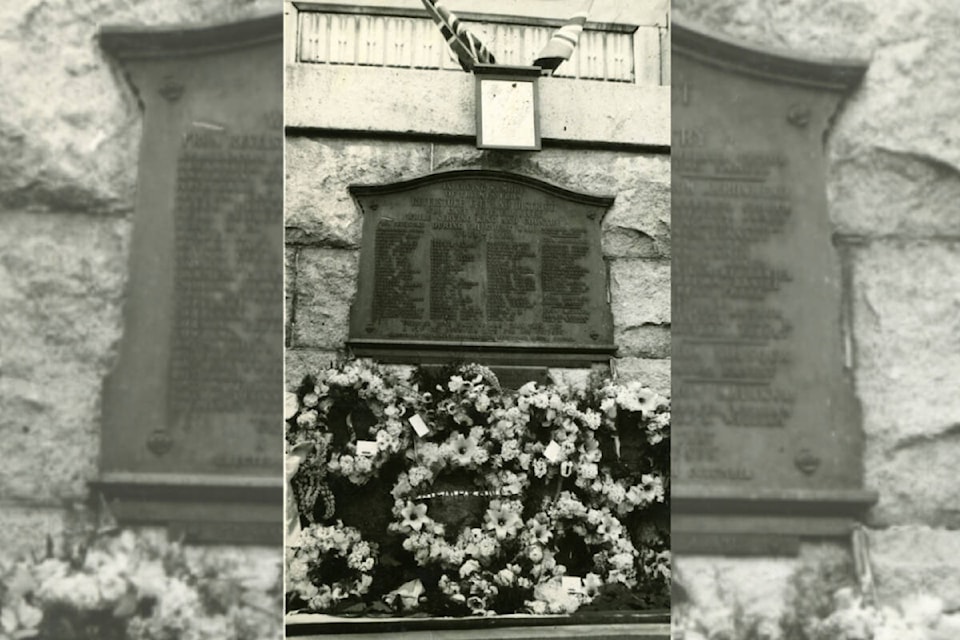By Cathy English
Curator, Revelstoke Museum and Archives
The First World War ended at 11 a.m. on Nov. 11, 1918, bringing an end to four brutal years of warfare and death.
The people of Revelstoke celebrated with a community-wide parade involving all of the schoolchildren, and most of the citizens.
Each year after that, Armistice Day was celebrated on Nov. 11.
In 1921, the poppy was first introduced as a symbol of those who died in the war. The tradition was started by Moina Michael, an American YMCA Overseas War Secretaries worker who was inspired by the poem “In Flanders Field” by Lieutenant Colonel John McRae, a Canadian military office who himself later died in combat.
The idea behind the poppy quickly spread, and by 1921, communities across the Commonwealth had adopted it as a symbol. In Revelstoke, the 1921 Armistice Day service was being referred to as Poppy Day, and everyone was encouraged to purchase a paper poppy.
The Great War Veterans Association, the forerunner to the Royal Canadian Legion, was in charge of the campaign, which had three objectives.
• To inaugurate the custom of wearing the poppy as a memorial flower on Armistice Day, to cherish the memory of those who died
• To provide relief funds to meet the needs of unemployed veterans
• To aid the orphaned children in France by purchasing poppies made by them and their supporters
At 11 a.m. on Nov. 11, 1921, two minutes of silence were observed through the city, including at the CPR station and shops and throughout the downtown and in the schools. The parade began at City Hall at 2:30 p.m. and was largely attended in spite of a heavy rain. The parade was led by a large group of returned soldiers, who were followed by the school children, and representatives from many local organizations.
RELATED: Remembrance Day: Let us pause to remember-Cathy English
Captain T.E.L. Taylor, of the former 54th Kootenay Battalion, was in charge of the memorial service at the Courthouse.
At that time, the only memorial to the war dead was the plaque that is still in place on the front wall of the Courthouse.
That plaque was placed there by the Women’s Canadian Club in 1919, and dedicated by Edward, Prince of Wales that same year.
At the 1921 service, Rev. R.R. Morrison spoke of the symbol of the poppy.
“The poppy was symbolical of the blood of sacrifice and was therefore being worn by all citizens.”
He concluded his address by reciting In Flanders Field. The Last Post was then sounded by bugler H.V. Morgan Jr.
Every citizen present wore a poppy, which had been made by the widows and orphans of French soldiers. The sale of poppies and wreaths raised the sum of $170.
In 1923, the Cenotaph was built, and the plaque with the names of those who died in World War II was added at the end of that conflict.
Armistice Day was renamed Remembrance Day in 1931, and it was proclaimed a public holiday that year. The annual Remembrance Day ceremony is an important day each year when we remember those who made sacrifices in times of war.
For the second year in a row, the services will be impacted by the COVID-19 pandemic, but we hope that everyone finds a way to remember in their own way.
Visit revelstokemuseum.ca and look under collections for profiles of Revelstoke’s casualties in World War I and World War II.
READ MORE: Photos: Remembrance Day in Revelstoke during COVID-19
Sign up for the Revelstoke Review’s daily newsletter.
@RevelstokeRevue
editor@revelstoketimesreview.com
Like us on Facebook and follow us on Twitter.
